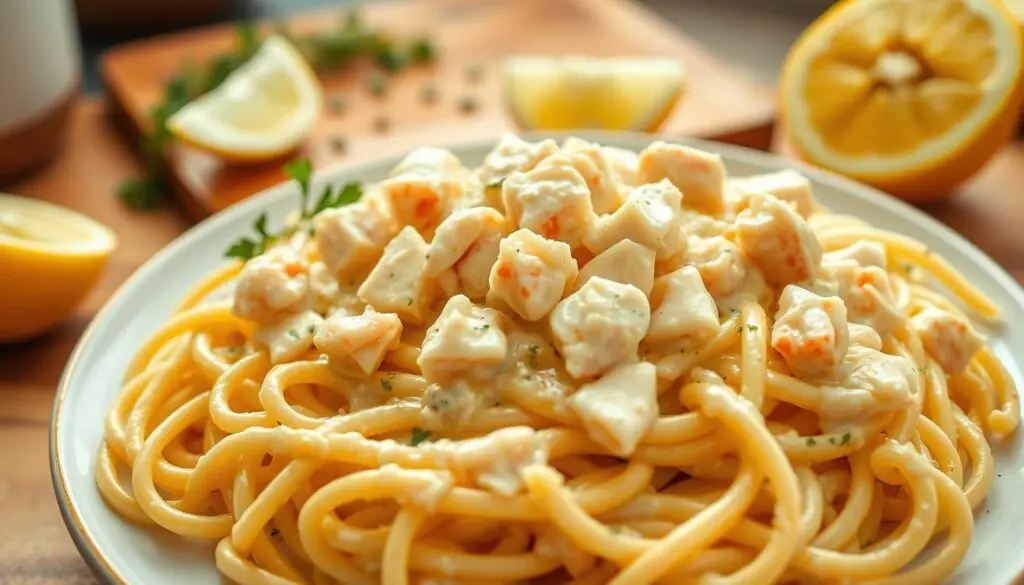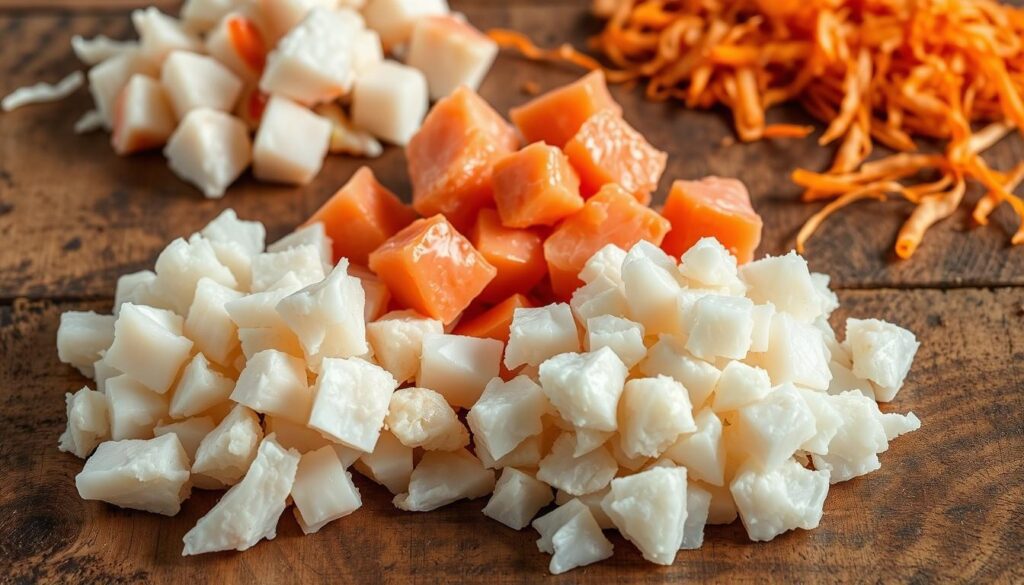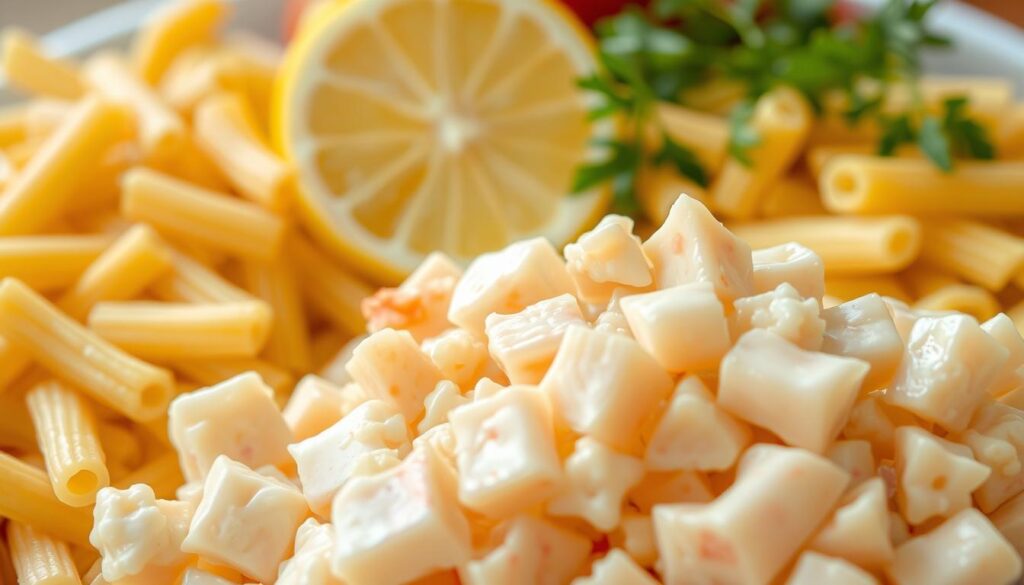best recipes for you
Lump Crab Meat Pasta: Develop an easy, creamy pasta recipe
Table of Contents

Explore the ultimate culinary adventure with a top-notch lump crab meat pasta. It turns your kitchen into a fancy dining spot. This dish mixes the softness of fresh crab with a rich creamy sauce. It’s a meal that will wow everyone, and it’s easy to make.
Making the best lump crab meat pasta means picking the right ingredients and knowing a few cooking tricks. You’ll find out how to turn a basic pasta dish into a fancy dinner. It will look and taste like it was made by a pro chef.
If you’re planning a special dinner or want to wow your guests, this recipe is perfect. It’s a simple way to make a fancy seafood pasta. The fresh crab meat’s sweet flavor shines through.
Key Takeaways
- Learn to prepare a restaurant-quality pasta with minimal cooking skills
- Understand the importance of selecting high-quality lump crab meat
- Master a creamy sauce technique that complements seafood perfectly
- Create an impressive meal in under 30 minutes
- Discover professional tips for maintaining crab meat’s delicate texture
Understanding Different Types of Lump Crab Meat
Choosing the right crab meat can make your pasta dish amazing. Jumbo lump crab and backfin crab meat have unique tastes and textures. They can take your cooking to the next level.

Crab meat has different grades, each with its own traits. Knowing these differences helps you pick the best for your seafood dishes.
Jumbo Lump Crab vs. Backfin Crab Meat
Jumbo lump crab meat is the top choice. It’s from the crab’s fins and has:
- Exceptional visual appeal
- Delicate, sweet flavor
- Larger, intact meat pieces
- Perfect for showcase dishes
Backfin crab meat is a more affordable option. It’s from the body and has:
- Smaller, broken meat pieces
- Rich crab flavor
- Great for mixed dishes
- More affordable option
Fresh vs. Pasteurized Crab Meat
When buying fresh crabs, you’ll find two main types:
- Fresh Crab Meat: Highest quality, needs to be used right away
- Pasteurized Crab Meat: Lasts longer, quality stays consistent
How to Select Quality Crab Meat
Choosing great crab meat requires a close look. Look for:
- Bright, clean white or ivory color
- Minimal liquid in packaging
- Fresh, mild ocean scent
- No discoloration or strong fishy smell
By knowing these differences, you can pick the best jumbo lump crab or backfin crab meat for your dishes.
Essential Ingredients for Creamy Crab Pasta

To make a delicious creamy crab meat pasta, you need the right ingredients. These ingredients will make your dish taste amazing and feel luxurious. Choosing the right ingredients can turn a simple meal into a special treat.
Begin with top-notch crab meat as the main attraction. Use fresh or pasteurized lump crab meat for the best taste and texture. The quality of your crab meat will greatly affect how your pasta tastes.
- Pasta Selection: Pick medium pasta shapes like fettuccine or linguine. They hold the creamy sauce well.
- Cream Base: Heavy cream or half-and-half makes a rich, creamy sauce.
- Aromatics: Add fresh garlic, shallots, and green onions. They bring a deep flavor to your crab sauce.
Seasonings are key to making your crab pasta truly special. Here are some must-haves:
- Fresh parsley
- Lemon zest
- Sea salt
- White pepper
- Mild paprika
If you follow a special diet, don’t worry. You can swap out ingredients. Try gluten-free pasta, lactose-free cream, or plant-based butter. This way, you can enjoy your creamy crab pasta without giving up flavor.
Kitchen Tools and Equipment Needed
To make a tasty fresh crab meat pasta, you need the right tools and equipment. Good cookware and utensils make cooking easier and more fun.
Choosing the right equipment is key for a great pasta dish with fresh crab. Your kitchen should have tools that work well and efficiently.
Recommended Pasta Cookware
- Large stainless steel stockpot (8-10 quart) for boiling pasta
- Heavy-bottomed saucepan for creating cream sauce
- Non-stick skillet for finishing the dish
- Ceramic or enameled cast-iron pan for even heat distribution
“The right cookware can elevate your fresh crab meat pasta from good to extraordinary.” – Professional Chef
Essential Utensils and Measuring Tools
When working with fresh crab meat, precision is important. You’ll need:
- Pasta tongs for easy handling
- Wooden spoon for stirring sauces
- Digital kitchen scale for accurate ingredient measurements
- Liquid and dry measuring cups
- Stainless steel colander for draining pasta
Pro tip: Invest in high-quality tools that will last and make your cooking process more enjoyable.
Preparing Your Lump Crab Meat
When working with lump crab meat, it’s important to handle it carefully. This helps keep its delicate texture and rich flavor. Fresh crabs are the best choice for your pasta dish, so precise handling is key.
Before starting, make sure you have these tools ready for preparing your lump crab meat:
- Small fine-mesh strainer
- Clean cutting board
- Soft paper towels
- Chilled serving bowl
Follow these steps for the best preparation:
- Check the lump crab meat for any shell fragments
- Pat the meat dry with paper towels
- Remove any cartilage or dark membrane pieces
- Break larger pieces into smaller, uniform sections
Pro tip: Always keep your fresh crab meat refrigerated until you’re ready to use it. Keep it below 40°F to prevent bacterial growth and keep the flavor fresh.
When handling the crab meat, be gentle. Avoid mixing or pressing too hard, as it can damage the meat’s texture. Your aim is to keep the lumps whole for a luxurious pasta experience.
Creating the Perfect Cream Sauce Base
Making a great cream sauce is key to making your crab meat pasta amazing. The right sauce can make your dish stand out. It brings out the crab meat’s flavor and makes the meal feel special.
Starting your cream sauce journey means knowing the basics. Choosing top-notch ingredients and learning the right techniques are essential.
Selecting the Right Cream
Choosing the right cream is important for your crab meat sauce. Here are some options:
- Heavy cream for ultra-rich texture
- Half-and-half for lighter consistency
- Mascarpone for velvety smoothness
Incorporating Aromatics and Seasonings
Aromatics add life to your crab meat sauce. Use minced garlic, shallots, and fresh herbs. They turn a simple cream base into a dish to remember.
| Aromatic | Flavor Profile | Recommended Quantity |
|---|---|---|
| Garlic | Sharp, pungent | 2-3 minced cloves |
| Shallots | Mild, sweet | 1 finely chopped |
| Chives | Delicate onion flavor | 1 tablespoon chopped |
Achieving the Ideal Sauce Consistency
The sauce should coat the spoon without being too thick or runny. Use gentle heat and stir constantly. This keeps the sauce smooth and perfect for your crab meat.
Pro tip: If your sauce gets too thick, add warm pasta water a little at a time. This will get it just right again.
Choosing and Cooking the Right Pasta
Choosing the right pasta for your jumbo lump crab dish is key. The perfect pasta shape can make your dish even better. It should match the delicate texture of the crab.
Look for pasta shapes that hold sauce well. Good choices include:
- Linguine: Its smooth surface is great for sauce
- Fettuccine: Its wide noodles add a luxurious feel
- Shells: They hold creamy sauce in their pockets
- Rigatoni: Its ridged surface catches sauce well
Cooking pasta right is important. Here’s how to do it:
- Use a big pot with lots of salted water
- Keep the water boiling while cooking
- Stir now and then to stop sticking
- Check for al dente – firm but not hard
For jumbo lump crab pasta, save one cup of pasta water before draining. This starchy water makes a silky sauce. It coats your pasta and crab meat beautifully.
Cooking time depends on the pasta type, usually 8-12 minutes. Always check the package and taste it to get it just right.
Combining Pasta with Lump Crab Meat
Making the perfect lump crab meat pasta needs careful steps. The last steps are key to keeping the seafood’s flavor and texture right.
When mixing pasta with lump crab meat, timing is key. You want to warm the backfin crab gently. This way, it stays soft and doesn’t get tough.
Gentle Incorporation Techniques
Here are important steps to keep your crab meat intact:
- Remove pasta from heat before adding crab meat
- Use low to medium heat when mixing
- Fold crab meat gently with a soft spatula
- Minimize stirring to prevent breaking meat chunks
Temperature Considerations
Keep the crab meat warm but not hot. Aim for 145°F to ensure it’s safe and not overcooked. The pasta and sauce’s heat will warm the crab just right.
Texture Preservation Strategies
Handling the crab meat gently is important. Backfin crab can break easily if handled roughly. Be gentle when mixing it into your pasta.
Let the crab meat be the star. Its natural sweetness should shine through.
Adding Final Touches and Garnishes
Turning your fresh crab meat pasta into a masterpiece is all about the details. The right garnishes can make your dish stand out. It’s like having a restaurant-quality meal at home.
Here are some top garnish ideas for your fresh crab meat pasta:
- Fresh herbs like finely chopped chives or parsley
- A zesty squeeze of fresh lemon juice
- Delicate shavings of high-quality Parmigiano-Reggiano cheese
- Cracked black pepper for added depth
- Micro greens for sophisticated visual appeal
How you present your pasta is just as important as how it tastes. Use white plates to make the colors pop. Create height by gently twirling pasta with tongs.
“Garnishing is the final brushstroke that turns a good dish into a culinary masterpiece.” – Professional Chef
Your aim is to make a dish that looks as good as it tastes. Garnishes bring out the crab meat’s delicate texture. They add depth and complexity to your pasta.
Storage and Reheating Tips
Keeping your crab meat pasta fresh and tasty is important. You need to store and reheat it carefully. This way, you can enjoy your meal safely and with great flavor.
Leftover crab meat pasta can stay delicious with the right care. Refrigeration is essential to keep it fresh and safe.
Refrigeration Guidelines
- Store crab meat pasta in an airtight container
- Refrigerate within 2 hours of cooking
- Keep refrigerated for no more than 3-4 days
- Use shallow containers to help cool the pasta quickly
Reheating Strategies
Reheating crab meat needs a gentle approach. This prevents it from becoming tough or rubbery. Here are some good ways to reheat:
- Stovetop Method: Reheat in a pan over low heat, adding a splash of cream to restore moisture
- Oven Technique: Warm in an oven-safe dish at 350°F, covered with foil to prevent drying
- Stir occasionally to distribute heat evenly
- Add a little extra cream or butter to refresh the sauce
Avoid microwaving as it can overcook the crab meat. When reheated right, your crab meat pasta can taste almost as fresh as when it was first made.
Wine Pairing and Serving Suggestions
Enhancing your lump crab meat pasta is more than cooking. The right wine can make your meal unforgettable. Choose a wine that complements the crab’s delicate flavor without overpowering it.
White wines are the top choice for seafood dishes. Here are some great options:
- Sauvignon Blanc – its crisp acidity pairs well with creamy pasta
- Chardonnay – its smooth texture goes well with the crab
- Pinot Grigio – a light and refreshing choice
If you prefer reds, a chilled Pinot Noir is a good pick. It won’t overshadow the crab’s rich taste.
Here are some tips to make your meal even better:
- Use warmed pasta bowls for serving
- Add fresh herbs as a garnish
- Pair it with a light arugula salad
- Offer crusty bread for dipping in sauce
Temperature is key when serving your pasta. Serve it right away to keep the flavors and textures perfect. A well-picked wine and nice presentation will wow your guests and make the meal unforgettable.
Conclusion
Making a tasty crab pasta dish at home is simpler than you think. With the right methods and top-notch fresh crabs, you can turn a basic meal into a fancy dish. The secret is to pick the best crab meat and follow the steps in this recipe.
Your crab meat cooking adventure doesn’t stop here. Every time you make this dish, you’ll find new ways to make it your own. Whether you’re an experienced cook or just starting out, this recipe is flexible for everyone. Try different herbs, cream bases, or pasta types to make your dish even better.
We urge you to enjoy the cooking process, trust your instincts, and most importantly, enjoy the delicious outcome. Fresh crabs make a great base for a memorable meal to share with loved ones. Your skills in making this luxurious pasta will surely impress and inspire your guests.
Remember, cooking is an art that’s unique to each person. Your personal touch makes every dish special. So, get your ingredients ready, follow the techniques, and let your creativity shine with this amazing crab meat pasta dish.
FAQ
What’s the difference between jumbo lump and backfin crab meat?
Jumbo lump crab meat comes from the swimming fins and is the largest, most intact pieces. Backfin crab meat is a mix of smaller pieces from the crab’s body. Jumbo lump is great for premium dishes because of its large, appealing chunks. Backfin is more affordable and works well in recipes needing a uniform texture.
How do I know if crab meat is fresh?
Fresh crab meat should smell like the ocean, not too fishy. It should be white to light pink, moist but not watery. Check the packaging for a recent date and buy from trusted suppliers. It should be uniform in color and free of brown spots.
Can I use pasteurized crab meat for my pasta?
Yes, pasteurized crab meat is a good choice for pasta. It’s safe and convenient, having been heat-treated to last longer. Just drain it well and gently mix it into your sauce to keep its texture.
How long can I store fresh crab meat?
Use fresh jumbo lump crab meat within 1-2 days when stored at 40°F or below. Keep it sealed in the coldest part of your fridge. If you can’t use it right away, freeze it for up to 3 months, though it might lose some texture.
What’s the best way to prevent overcooking crab meat?
Crab meat cooks fast and is delicate. Add it to your sauce just before serving and heat gently. Don’t stir too much to avoid breaking the meat. Stop heating when it’s just warm, around 145°F.
Can I substitute canned crab meat for fresh?
While you can use canned crab meat, it’s not the best for fancy pasta dishes. It’s softer and less flavorful than fresh. If fresh is not available, choose high-quality pasteurized crab meat for better taste and texture.
How can I tell if crab meat has gone bad?
Bad crab meat smells strongly fishy, has gray or yellow color, and feels slimy. If you see these signs, throw it away. Fresh crab should smell like the ocean and have a mild scent.







